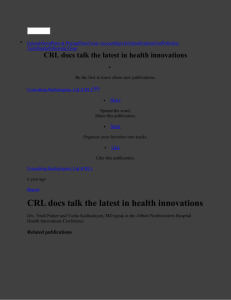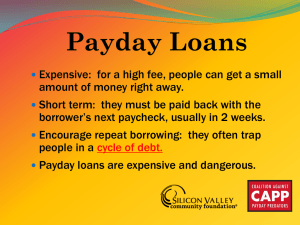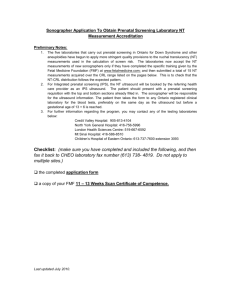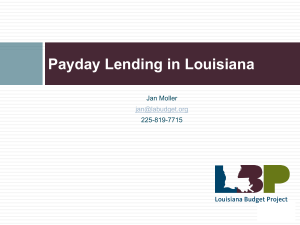Check Into Cash, Inc. PO Box 550 Cleveland, TN 37364-0550
advertisement
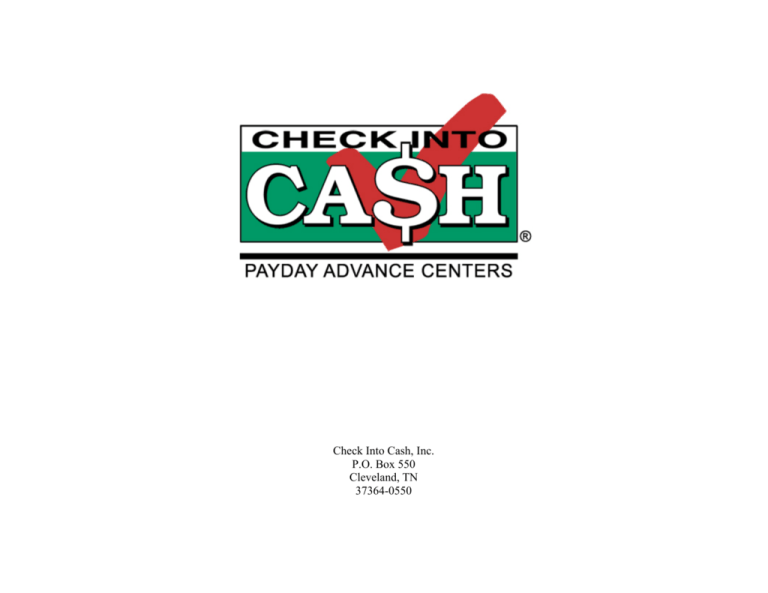
Check Into Cash, Inc. P.O. Box 550 Cleveland, TN 37364-0550 Exploiting the Myth of Excess Profits Chart1 Company Net Income Per Operating Location Build-A-Bear Workshops, $118,756 25,000 (from Company 10k reports) $120,000 Net Income per Location Number of Locations $100,000 20,000 $80,000 15,000 World Acceptance, $62,121 $60,000 10,000 $40,000 Advance America, $24,190 $20,000 H&R Block, $22,907 QC Holdings, $10,111 $0 2,604 Net Income Per Location Zale Corp (Jewelry), $22,828 Papa Johns Pizza , $15,160 532 21,408 620 Page 1 2,349 3,038 5,000 230 Number of Locations Real Profit from Average Payday Advance Fee Assuming an average Payday Advance of $100 provides a $15 Fee Publicly Traded Leading Payday Advance Companies Advance America Ticker Symbol Percent of Revenues TTM Net Income (09/2006) (1) Payday Advance Company Profit per $15 Fee Charged Trailing Twelve Month Net Incomes (1) Center for Responsible Lending Self Help Credit Union Profit per $15 Fee Revenues 2005 Net Income of 18.1% (2) AEA 10.40% $1.56 $2.72 EZPW 9.30% $1.40 $2.72 Cash Amercia CSH 8.60% $1.29 $2.72 QC Holdings QCCO 3.90% $0.59 $2.72 Dollar Financial DLLR 0.80% $0.12 $2.72 6.60% $0.99 $2.72 EZCorp Group Average (1) Trailing Twelve Months Net Income Percentage as of September 30, 2006; source: (2) Annual Net Profit Margin of 18.1% of Revenues; source: www.NCUA.Gov filed financial documents Yahoo! Finance Stock Screener PUBLICLY TRADED, LEADING PAYADAY ADVANCE COMPANIES, ANNUAL PERFORMANCE EXPRESSED AS AN A.P.R. BASE OF 391% AEA = Advance America; QCCO = QC Holdings; DLLR = Dollar Financial; CSH = Cash America; EZPW = EZCorp AEA QCCO Year Ended December 31, 2005 Year Ended December 31, 2005 CSH EZPW Year Ended December 31, 2005 Year Ended September 30, 2005 ------------------------------------ DLLR Year Ended June 30, 2006 ------------------------------------ ------------------------------------ ------------------------------------ ---------------------------------- Dollars APR ----------------------- ----------- Dollars APR ----------------------- ----------- Dollars APR ----------------------- ----------- Dollars APR ----------------------- ----------- Dollars APR ----------------------- --------- ----------------------- ----------630,066 391% ----------------------- ----------- ----------------------- ----------152,878 391% ----------------------- ----------- ----------------------- ----------320,991 391% ----------------------- ----------- ----------------------- ----------410,547 391% ----------------------- ----------- ----------------------- --------163,481 391% ----------------------- --------- Center Expenses: Provision for doubtful accounts and agency bank losse 115,060 71% Salaries and related payroll costs 171,092 106% Occupancy costs 80,540 50% Center depreciation expense 14,902 9% Other center expenses 76,849 48% ----------------------- ----------Total center expenses 458,443 284% ----------------------- ----------Center gross profit 171,623 107% 41,417 106% 38,073 97% 19,062 49% 3,890 10% 13,521 35% ----------------------- ----------115,963 297% ----------------------- ----------36,915 94% 29,425 36% 91,982 112% 22,899 28% 7,226 9% 62,371 76% ----------------------- ----------213,903 261% ----------------------- ----------107,088 130% 42,834 (Dollars in thousands) TOTAL REVENUES Corporate and Other Expenses (Income): General and Administrative expenses G&A Depreciation expense Interest Expense, net Loss on disposal of property and equipment Loss on impairment of assets (if applicable/available) Other expense (income), net Total corporate and other expenses Income before Income Taxes Provision for Income Tax Expense Income before income of consolidated variable interes 23,417 220,357 ----------------------286,608 ----------------------123,939 14,203 8,036 95,876 ----------------------118,115 ----------------------45,366 34% 0% 0% 19% 229% --------282% --------109% 51,758 4,483 3,980 715 2,918 32% 3% 2% 0% 2% 0% ----------------------- ----------- 25,585 856 (476) 65% 2% -1% 0% 0% 715 2% ----------------------- ----------- 38,913 3,776 33,878 47% 5% 41% 0% 0% 10,892 13% ----------------------- ----------- 43,227 41% 0% 8,996 9% 0% 0% 834 1% ----------------------- ----------- 55% 0% 3% 0% -5% 0% ----------------------- --------- 63,854 40% ----------------------- ----------107,769 67% 43,776 27% ----------------------- ----------- 26,680 68% ----------------------- ----------10,235 26% 3,912 10% ----------------------- ----------- 87,459 107% ----------------------- ----------19,629 24% 19,986 24% ----------------------- ----------- 53,057 51% ----------------------- ----------70,882 68% 26,061 25% ----------------------- ----------- 22,316 53% ----------------------- --------23,050 55% 8,298 20% ----------------------- --------- 63,993 6,323 40% (1,003) -1% Income of consolidated variable interest entity (if applic Discontinued Operations (if applicable/available) ----------------------- ----------NET INCOME $ 62,990 39% ============= ====== 16% 0% 944 ----------------------- ----------$ 5,379 14% ============= ====== (357) 0% 44,821 43% 23,067 68 1,275 79 (2,173) 14,752 35% 0% 0% 0% ----------------------- ----------$ (357) 0% ============= ====== (197) ----------------------- ----------$ 45,018 43% ============= ====== ----------------------- --------$ 14,752 35% ============= ===== ALL DATA BASED ON FILED S.E.C. DOCUMENTS, ARRANGED FOR COMPARISON PRESENTATION, SOURCE DOCUMENTS CAN BE FOUND AT: AEA http://yahoo.brand.edgar-online.com/fetchFilingFrameset.aspx?FilingID=4281683&Type=HTML QCCO http://yahoo.brand.edgar-online.com/fetchFilingFrameset.aspx?FilingID=4274867&Type=HTML DLLR http://yahoo.brand.edgar-online.com/fetchFilingFrameset.aspx?dcn=0000893220-06-002028&Type=HTML CSH http://yahoo.brand.edgar-online.com/fetchFilingFrameset.aspx?dcn=0000950134-06-004135&Type=HTML EZPW http://yahoo.brand.edgar-online.com/fetchFilingFrameset.aspx?dcn=0000950134-05-023136&Type=HTML Individual Expense Line Item That Exceed 36% APR 41% 0% 0% 22% 210% ----------273% ----------118% Payday Advance Companies compared to Federal Credit Unions 2005 NET INCOME for Every $1 OF REVENUE RECEIVED (from SEC Filed 10k reports and NCUA Filed financial reports) $0.25 $0.18 $0.17 $0.17 $0.17 $0.14 $0.11 $0.15 $0.11 $0.09 $0.08 $0.07 $0.06 PAYDAY ADVANCE COMPANY GROUP (1) SELF-HELP NAVY PENTAGON STATE VIRGINIA SOUTH ALLEGACY COASTAL LANGLEY STATE SAFE TRULIANT # 66258 # 5536 # 227 EMPLOYEES' CREDIT CAROLINA # 24438 # 18297 # 1261DEPARTMENT # 9988 # 7840 # 66310 UNION, INC., # 1022 # 435 # 66836 (1) Payday Advance Company Group consists of the 5 Publicly Traded Payday Advance Companies referred to throughout this site: Advance America, QC Holdings, Cash America, EZCorp, Dollar Financial For every $1.00 in profit earned by the Self-Help Credit Unions, the average profit earned by the 11 Federal Credit Unions would have been $0.75, and the average profit earned by the 5 public payday companies only $0.36 (1) $1.00 $0.90 $0.80 33% MORE THAN THE CREDIT UNION AVERAGE 174% MORE THAN THE PAYDAY COMPANY AVERAGE $0.70 $0.60 $0.50 $0.40 $0.30 $0.20 $0.10 $- Self Help Credit Unions 11 Credit Unions, Average (1) Based on the Net Incomes of Revenue of 18.1% (Self Help); 13.6% (Credit Union Average); 6.6% (Payday Company Average) 5 Payday Companies, Average Charter 5536 227 66310 Credit Union Name NAVY PENTAGON STATE EMPLOYEES' 66836 VIRGINIA CREDIT UNION, INC., 1022 24438 18297 1261 435 9988 7840 SOUTH CAROLINA ALLEGACY COASTAL LANGLEY STATE DEPARTMENT SAFE TRULIANT The following data is from www.NCUA.gov website, 2005 Financial Performance reports filed ASSETS Unsecured Loans TOTAL LOANS Unsecured Loans as a percent of Total Loans 3,398,536,677 16,703,197,810 1,074,533,927 462,824,646 250,474,104 112,709,974 97,309,153 81,606,597 80,765,787 90,212,879 39,531,519 87,409,096 7,215,724,046 10,185,022,585 820,539,863 986,195,208 851,481,013 1,274,257,445 444,352,498 486,645,876 260,522,945 932,151,486 20% 15% 5% 31% 11% 11% 6% 18% 19% 15% 9% 1,032,532,896 218,436,136 361,321,405 1,612,290,437 361,530,315 32,767,980 44,515,500 438,813,795 489,493,322 59,507,690 104,902,472 653,903,484 52,678,508 12,575,738 21,058,632 86,312,878 57,943,384 4,658,497 30,501,176 93,103,057 45,330,314 5,843,204 20,052,187 71,225,705 74,519,840 7,301,593 20,382,357 102,203,790 29,702,349 21,783,372 15,617,305 67,103,026 30,367,939 11,188,405 6,871,010 48,427,354 16,072,278 4,736,161 6,658,657 27,467,096 49,061,229 2,613,257 14,507,898 66,182,384 22% 10% 16% 24% 33% 28% 20% 23% 14% 24% 22% 244,369,549 19,229,609 25,500,000 7,683,789 9,600,000 5,119,191 9,800,000 3,191,402 2,666,806 829,660 3,553,267 15% 266,336,966 17% 4% 108,103,290 25% 4% 61,586,714 9% 9% 9,727,627 11% 10% 15,575,917 17% 7% 4,033,768 6% 10% 14,315,105 14% 5% 10,103,166 15% 6% 8,138,668 17% 3% 2,956,840 11% 5% 5,560,080 8% INCOME Loan Revenue Investment Revenue Other Revenue Total Revenue "Other Revenue" as a percent of Total Revenue Prov for Loan/Lease Losses* Prov for Losses as a percent of Total Revenue Net Income* The following data is from 2005 Annual Reports were available Non-Disclosed Fees ATM FEES OVERDRAWN CHECK FEES Total ATM/Overdrawn Fees Percent of Other Revenue 33,264,000 21,564,015 6,836,306 15,280,367 103,948,000 33,264,000 28,400,321 15,280,367 29% 75% 93% 98% 24,922,000 79,026,000 SOURCES: http://www.ncua.gov/indexdata.html Once on NCUA page enter the Charter Number of a specific credit union (ex. Navy = 5536), Click "Find" then click "View Report" Comparision of Annual Net Income Percent of Revenue Hilton Hotels Corp., 10.4% H & R Block, Inc., 10.1% Applebee's Intl., 8.4% Southwest Airlines Co., 7.2% HanesBrands, Inc., 7.2% Home Depot, Inc., 7.2% Hewlett-Packard Co., 6.9% The J.M. Smucker Company, 6.7% JB Hunt Transport Services, Inc., 6.6% Toyota Motor Corp., 6.5% Lowe's Companies, Inc., 6.4% Kohl's Corp, 6.3% Dress Barn, Inc., 6.1% J C Penney Corporation, 5.8% Self-Help Credit Unions, 18.2% (1) Advance America, Cash America, Dollar Financial, QC Holdings, EzCorp Average of Five Publicly Traded Payday Advance Companies (1), 6.6% NOTE: The statement below, from Check Into Cash founder and CEO Allan Jones, came about as a result of an article from the Center for Responsible Lending (CRL), a front group that is critical of the payday advance industry. CRL is a well-funded, anti-free enterprise group that disguises itself as a consumer advocacy organization. The truth is that CRL was created by the Self-Help Credit Union, a credit union that stands to make huge monetary gains if payday lending is banned. Their tactics of deceit reflect this desperation to eliminate consumer choice. Comparisons Show Payday Advance Industry Profit Margins 'Modest' Compared To Fortune 500 Group Top bank profit margins are 4 times as high, says Allan Jones, Chairman of Check Into Cash, Inc. CLEVELAND, Tenn., Dec. 14 /PRNewswire/ -Allan Jones, Chairman and CEO of Check Into Cash, Inc., one of the largest privately held payday advance companies with over 1250 locations nationwide, took issue today with the recent attack on the industry by the Center for Responsible Lending (CRL). Jones calls the CRL, the "Center for Irresponsible Information." CRL says the rates currently being charged by payday advance companies are predatory and their profits exorbitant. Jones says their claims are "unfounded and irresponsible." While Jones' company is privately held, he released a list of five publicly traded payday advance companies' bottom line earnings. "We have said all along that it takes a $15 fee or more per $100 advanced in order for these companies to provide their service. If you look at the bottom-line numbers, any reasonable person will conclude that $15 per $100 is as low as a company can go and stay in business." Advance America, for example, with more than 2750 centers nationwide, led the industry in performance with a 10.4% profit, followed by EZ Corp at 9.3%, Cash America at 8.6%, QC Holdings with 3.9%, and Dollar Financial with 0.8%. The industry as a whole averages about 6.6%, which Jones calls "modest." "You cannot call payday companies predatory unless you compare their bottom-line percentage profits to other industries' bottom-line profits. In that case, you'd also have to call Wrigley's Chewing Gum, General Electric, Mattel, and the International House of Pancakes predatory! While Advance America earned 10.4%, IHOP Corp earned 12.6% -- that's 21% more! If CRL wants to label the payday industry as predatory, then by golly they've gotta call Jack in the Box, Steak & Shake and PetSmart predatory as well, because they earn a higher bottom-line percentage than QC Holdings' 560 payday centers. I wonder why CRL doesn't try to figure out how much of what they would describe as 'hard-earned cash siphoned out of the wallets of hard-working American citizens' is spent buying those over-priced predatory dog collars and fish bowls at PetSmart? You would only make that statement if your information is fishy, fishy, fishy," Jones concluded. Jones pointed out that on average the profit margins of the top banks are 26.52% compared to 6.6% for payday companies. The banks' profit margins are 301% greater, or four times higher, than the five public payday advance companies he cites. "How can the CRL call a $200 payday loan 'financial quicksand' ignoring bank late charges, bounced checks fees, ATM fees, over- draft protection, and $20,000 credit card balances? This equates to four times greater bottom-line profit than the small mom-and-pop payday advance companies being targeted by CRL." Jones pointed out that he personally has bounce protection and credit cards and doesn't mind ATM fees to access his cash. "It's just a fact that bank fees are more profitable than payday fees, but I certainly would not want CRL eliminating my banking options." APR disclosures, while required by federal law, are misleading for micro- lenders. For example, a typical payday loan of $100 with a $15 one-time fee and a term of 14 days generates an APR of 391%, but the fee is still $15. In fact, a loan would have to be renewed every two weeks for a year to realize an APR of 391%, impossible under Tennessee and most state laws. "Annual percentage rate is a red herring on this form of micro-credit lending." Jones insists that the $15 fee is a much clearer way for consumers to determine the true cost of services, not the fact that the APR jumps 30 percentage points because the loan is paid off one-day early or decreases 26 percentage points if one day late. He went on to use Wal-Mart as an example. He estimates they have a 30% mark-up on a two week shelf life. Jones equated fishing rods with a wholesale price of $100, which sell for $130. "If those rods stay on the shelf two weeks before being sold, that would create a 782% APR yield for Wal-Mart ($30 return on a $100 investment for 14 days). If the fishing rod only stayed on the shelf 7 days, then Wal-Mart would have an APR return on their investment of 1564%, which is very misleading. It is still 'Always Low Prices, Always' because the $30 mark-up doesn't change. Jones said this allows people like the CRL to create an APR monster out of smoke and mirrors, misleading consumers and the press into believing that the payday industry is charging exorbitant fees. "That is why it's unconscionable, in my opinion, to use APR in the manner used by CRL. They are just trying to alarm the public, for their own benefit. That's why you need to look at the bottomline earnings, and the real truth is payday fees are reasonable," said Jones. CRL and some of their other cohorts want to limit the fee payday advance companies can charge to 36% APR. According to Jones, "this would quickly put us out of business because it would cut our fee from $15 for a $100 advance to $1.38." He went on to point out that if a person needed $100 for 7 days rather than 14, the maximum amount a company could charge at 36% APR would be 69 cents. "This would not even pay for the paper we use in the office bathroom! This just shows how ridiculous the CRL's argument that 36% is a fair amount to charge really is! How long could Starbucks stay in business if CRL cut the charge for a cup of coffee to $1.38?" Jones charges that the CRL misrepresents these numbers in an "effort to obtain more donations from anti-business foundations and advance their legislative agenda of socializing credit." Jones estimates that CRL "is currently spending about $30 million to defeat a relatively large but unorganized industry of micro-credit lenders, by quoting the cost of a 365-day rate on a 14-day transaction." Regarding the Center for Responsible Lending, based in Durham, NC, Jones concluded: "Heck, with $30 million, they could brand anything, even the Andy Griffith Show, as predatory!" Trailing Twelve Months Net Profit Margin Comparisons SOURCE: Publicly accessible Yahoo.com Finance Stock Screener Advance America comparisons 1 PROCTER GAMBLE CO 13.0 % 2 MCAFEE, INC 12.9 % 3 BERKSHIRE HATH HLD A 12.9 % 4 ANHEUSER BUSCH 12.9 % 5 SANDISK CP 12.9 % 6 DOW JONES CO INC 12.8 % 7 C S X CP 12.8 % 8 I H O P CORP 12.6 % 9 TEMPUR-PEDIC INTL 12.4 % 10 ABERCROMBIE & FITCH 12.4 % 11 ST. JUDE MEDICAL 12.3 % 12 ALLIS-CHALMERS ENRGY 12.3 % 13 BURLINGTN N SANTE FE 12.3 % 14 AT&T INC. 11.8 % 15 BRISTOL MYERS SQIBB 11.8 % 16 THE HERSHEY COMPANY 11.6 % 17 WORLD WRESTLING ENT 11.3 % 18 COLGATE PALMOLIVE 11.0 % 19 MATTEL INC 10.9 % 20 WRIGLEY WM JR CO 10.8 % 21 GEN ELECTRIC CO 10.8 % 22 ADVANCE AMERICA INC. 10.4 % 2,750 Payday Advance Centers in 36 States QC Holdings comparisons 1 TARGET CP 2 ALCAN INC 3 THE STEAK N SHAKE CO 4.6 % 4.5 % 4.4 % 4 5 6 7 8 9 10 11 12 PET SMART INC 4.3 % FOOT LOCKER INC 4.2 % ROSS STORES INC 4.1 % FRIEDMAN INDS INC 4.1 % JACK IN THE BOX INC 4.0 % DOLLAR THRIFY AUTO 3.9 % RYDER SYSTEM INC 3.9 % CASUAL MALE RETAIL 3.9 % QC HOLDINGS, INC. 3.9 % 560 Payday Advance Centers in 25 States Acquired 51 Centers Dec 1, 2006 for a total of 611 Centers Top ten bank holding companies in the U.S. ranked by assets [1] source: http://en.wikipedia.org/wiki/Banking_in_the_United_States [1] As of September 30, 2006 1 2 3 4 5 6 7 8 9 10 Citigroup Inc. - 1.746 trillion 29.3 % Bank of America Corp. - 1.452 trillion 30.8 % J.P. Morgan Chase & Co. - 1.338 trillion 22.4 % Wachovia Corp. - 560 billion 26.4 % Wells Fargo & Co. - 483 billion 25.2 % HSBC North America Inc. - 474 billion n/a foreign co Taunus Corp. - 430 billion 17.0 % U.S. Bancorp - 217 billion 36.4 % Countrywide Financial Corp. - 193 billion 23.7 % SunTrust Banks, Inc. - 183 billion 27.5 % Publicly Traded Payday Advance Companies 1 ADVANCE AMERICA INC. 2 EZCORP INC CL 3 CASH AMERICA INTL INC 4 QC HOLDINGS, INC. 5 DOLLAR FINANCIAL CORP Widely Recognizable companies that are double or triple comparisons 1 PROVIDENT FIN HLD 2 QUALCOMM INC 3 MOODY'S CORP 4 DOLBY LABORATORIES 5 LEHMAN BROS HLD 6 MERCK CO INC 7 JP MORGAN CHASE CO 8 COCA COLA CO THE 9 LILLY ELI CO 10 CHOICE HOTEL INT NEW 11 WESTERN UNION COMPAN 12 ALEXANDERS INC 13 FIRST REPUBLIC BANK 10.4 % 9.3 % 8.6 % 3.9 % 0.8 % 34.1 32.8 32.6 22.9 22.9 22.7 22.4 22.2 21.1 21.0 20.7 20.0 19.0 % % % % % % % % % % % % % The following news release was issued by CFSA, the payday advance industry's trade association, in response to CRL's "Financial Quicksand" story from Dec. 2006. Report on Payday Loans Doesn’t Add Up Center for Responsible Lending’s Irresponsible Math Misleads Consumers and Policymakers Washington, D.C. – The recent report from Center for Responsible Lending (CRL), “Financial Quicksand,” purposely deceives consumers and policymakers by using “evidence” that simply does not exist. The entire report should be discredited, according to the Community Financial Services Association of America (CFSA), the national trade association of responsible payday lenders. “CRL has taken data points from various sources, applied their own convoluted math and passed it off as information confirmed by state regulators and third parties,” said Darrin Andersen, CFSA president. “In reality, CRL has applied its own ‘assumptions,’ ‘calculations’ and ‘adjustments’ to the original data points. They also take the liberty of ‘estimating’ data that simply does not exist,” Andersen said. “By publishing false information in their reports, CRL is misleading consumers, legislators and the media who believe and repeat their false allegations. Any report released by CRL should be reviewed carefully in order to separate fact from the fiction they use to make up their allegations,” said Andersen. “CRL’s discredited claims about the costs of the typical payday advance and the inability of consumers to pay them back makes the overarching conclusion of the report invalid,” concluded Andersen. CRL Report: “The typical payday borrower pays back $793 for a $325 loan.” The Facts: A typical payday borrower pays back $52 for a $325 loan. In CRL’s calculation, the average borrower takes out nine loans per year, the average loan amount is $325 and typical fee per $100 borrowed is $16. For a loan of $325, the fee would be $52. However, CRL makes the assumption that eight of these loans are rollovers or extensions of the original loan. “This figure is absolutely wrong,” said Darrin Andersen, CFSA president. “To come up with that number, CRL counts the principal for only one loan but adds the fees for nine loans,” said Andersen. “While it makes for a good headline, CRL’s scenario is impossible.” In 37 states, rollovers are limited or prohibited. In states without limits, CFSA members limit the number of rollovers to four. Therefore, it is not possible for someone to roll a loan over in the manner CRL contends or to accrue the kinds of fees they claim. CRL Claim: “Ninety percent of payday advance revenue comes from borrowers who cannot pay off their loans when due.” The Facts: According to state regulator reports, more than 90 percent of transactions are paid when due and more than 95 percent are ultimately collected. The most recent reports from state regulators — without the “benefit” of CRL’s spin or re-calculations — show that more than 90 percent of transactions are paid when due and more than 95 percent are ultimately collected. (The filings of public companies show similar data.) Therefore, CRL’s assumption that borrowers who take out more than four loans are “trapped” and cannot pay them back is false. To use California, Virginia and Florida as examples: According to the California Department of Corporations 2005 Annual Report, only 7.05% of payday loan customer checks were returned unpaid and 3.44% were charged off as uncollectible. In Florida, “Trends In Deferred Presentment,” FL Office of Financial Regulation, August 2006 reports that 5.0% of customer checks were returned unpaid and 2.2% were charged off as uncollectible. The Virginia Bureau of Financial Institutions Annual 2005 Report indicates that 4.3% of customer checks were returned unpaid and 2.27% were charged off as uncollectible. CRL Claim: “Predatory payday lending now costs American families $4.2 billion per year in excessive fees.” FACT: The underlying premise to support this claim has no basis. CRL arbitrarily decided that taking out more than four payday advances in a year is inappropriate and that any consumer who does is caught in a “predatory debt trap.” This runs contrary to research showing that 92% of customers think payday lenders offer a valuable service and that 90% of customers are satisfied with their understanding of the terms and costs of payday loans. A majority of customers have used payday advances to avoid more costly bounced check fees or late charges on bills. But CRL makes no mention of the benefits reaped by these customers — the problems solved or the money saved versus more expensive options. It gives no attention to the possible harm caused by eliminating lawful access to payday advance credit and forcing them into less desirable and often unregulated alternatives. Exploiting the Myth of Rollovers and APR vs. Convenience Fee Real Math Tells the Story Rollovers (Most states do not allow rollovers and most states require the account to be paid in full before a new transaction can be initiated. Assuming a $15 fee – if paid regularly for 26 times in a year = $391.) The Center for Responsible Lending (CRL) consistently insists that the payday industry relies on rollovers for profitability. They allege the payday industry makes exorbitant amounts of money on rollovers, and that even if The consumer fails to pay back, the payday company makes money. Let’s do the math. (Refer to Real Profit from Average Payday Advance Fee) Since the industry average of five publicly-traded payday companies is 6.6%, assuming a $15 fee for $100 advanced creates a profit of .99 cents per transaction. Based on the .99 cents of profit per transaction, if the consumer failed to pay back the $100, the consumer would have had to roll the account over 102 times before the payday company made .99 cents. (.99 – 100 = 101.01%) In other words, on the102nd transaction, the payday company would earn its first $1 of income. If the consumer comes in, pays off and renews the transaction 102 times, the payday company would have advanced them $10,200. The math 102 advances at $100 each = $10,200. In other words, the consumer would spend 3 years and 22 pay periods to pay for the $100 charge off. On the 23rd pay period, the payday advance company would earn .99 cents. Misunderstood APR vs. Convenience of Fee The Center for Responsible Lending (CRL) is constantly barraging the payday advance industry for excessively high interest of what they term “charging 400% interest.” To prove this, you have to work the math, i.e., if a consumer comes in to get a $100 pay day advance, at 400% interest, the payback is $500. $100 x 400% = $400 interest plus $100 principal = $500…(this is incorrect!) The real math is a consumer needs $100 and the payday company charges $15 for a 14-day transaction, they are forced to “a 365-day rate of 391%.” ($15 x 26 times per year = 391% APR.) CRL regularly blurs the line between interest and the annual percentage, or APR. The interest is $15. The APR is 391%. If the consumer comes in one day early, on the 13th day, instead of the 14th day, the APR jumps 30 points to 421%. If the consumer comes in one day late, on the 15th day, the APR drops 26 points to 365%. Whether the consumer pays our $15 fee on the 13th day or the 15th day has no effect on the consumer. The fee is still $15. The fact that the APR moves 56 points from the 13th day to the 15th day makes no difference in the profitability. (421% - 365% = 56% APR) Because the fee remains $15. HOW THE CRL MANIPULATES $15 APR is misleading to consumers on a 14-day transaction and this demonstrates how a 36% cap is unrealistic APR jumps 56 points from paying off one day early v.s. paying off one day late BUT the fee remains $15 14-day transaction 391% $15.00 $15.00 421% Pay off 1 day early Pay off 1 day late 330% $15.00 340% 350% 56 point difference 365% 360% 370% 380% 390% 400% 410% 420% 430% Why would anyone pay 335% more for coffee? Payday advance centers are the convenience stores of the financial services industry. Convenience stores are designed to sell one or two small items at a time and charge much more than a supermarket – they offer a small selection of brand choices for the consumer. A great example is instant coffee! If you run out of instant coffee and go to a convenience store, you will find only one or two brand selections, available only in 2-ounce jars. The cost is $2.95, or $1.475 per ounce. You can go to the supermarket and find a large selection of brands and choices in 12 oz. jars at a cost of $5.29, which is only .44 per oz. $2.95 $1.475 per oz Why would anyone pay 335% more for coffee? The math: .44 x 335% = $1.474 The Answer: CONVENIENCE $5.29 .44 cents per oz. Exploiting the Myth of Consumer Dissatisfaction Customer Complaints per State Tennessee: Of the 606 complaints filed with the Department of Financial Institutions, the Deferred Presentment (or pay day), received zero (0) for 2005 Colorado: Does not retain this information for individual types of consumer lenders. However, in 2005 there were 253 total complaints against all consumer lenders. Deleware: Customer complaints are confidential. Florida: Does not retain this information for individual types of consumer lenders. However, in 2005 there were 215 total complaints for all consumer lenders. Kentucky: In 2005 there were 12 complaints involving payday lenders. Michigan: Does not retain this information for individual types of consumer lenders. However, in 2005 there were 986 total complaints for all consumer lenders. Montana: In 2006, there were 10 complaints involving payday lenders. Two complaints were against licensee payday lenders and 8 complaints were against internet payday lenders that were unlicensed. New Mexico: In 2005, there were 11 complaints against payday lenders. North Dakota: In 2006, there was 1 complaint against a payday lender. The customer was upset because he was denied a loan. However, he was denied a loan because he was over the allowable loan limit. Virginia: In 2006, there were 53 total complaints; 39 with licensed lenders; 14 unlicensed lenders Wisconsin: Does not maintain this information for specific industries; they group all consumer loans under the category of mortgages and would be unable to distinguish payday loans. South Carolina: Does not maintain this information for specific industrie Consumer Resources Division CONSUMER PROTECTION A key responsibility of the Division is the handling and tracking of consumer complaints. The Department of Financial Institutions is the only state agency that has the statutory jurisdiction to handle consumer concerns and complaints involving financial institutions operating under the various laws the Department administers in the State of Tennessee. The Division processes all complaints related to financial institutions chartered and licensed by the Department. If the Department receives information that do not fall within the Department’s jurisdiction, those inquiries or complaints are forwarded to the appropriate agency or entity and the consumer is accordingly advised. In all cases, the Division follows its routine practice of submitting the consumer’s written complaint to the financial institution for response and communicates this in writing to the complainant or forwards the complaint to the appropriate entity if the Department does not have jurisdiction. If a complaint indicates that further review is necessary, the complaint is referred to the appropriate regulatory Division in the Department for investigation as warranted. In addition, the information generated from consumer complaints will be used for specific consumer outreach initiatives as well as assisting the Governor and the General Assembly with developing legislative initiatives to ensure Tennesseans have access to sound, non-predatory financial institutions. In 2005, the following are the top 10 consumer complaints by industry: INDUSTRY TOTAL % OF TOTAL COMPLAINTS Default * 266 45% Banks 154 25% Mortgage Companies 142 23% Credit Unions 19 3% TILT** 14 2% Title Pledge 10 >2% Check Cashers 1 >1% Deferred Presentment 0 0% Premium Finance 0 0% Money Transmitters 0 0% 606 100% TOTAL: * Default category contains phone calls, e-mails, correspondence received, complaint form mailed but completed form not returned; complainant or financial institution was not under the Department’s jurisdiction and the complaint was referred to the correct regulatory authority. ** Tennessee Industrial Loan and Thrift 24 Consumer Resources Division 2005 TOP TEN CONSUMER COMPLAINTS BY ALLEGATION Customer Service Issues 1: 131 Misrepresentation : 63 2 Fraud : 44 3 Payment Processing; Payment History Dispute : 39 Unapproved Account Withdrawal : 25 Account Fee Issues : 23 Excessive Fees : 23 RESPA Good Faith Estimate Violations 8: 16 Privacy Issues : 16 4 5 6 7 9 Failure to Release Deed or Lien : 10 15 Issues included phone calls not returned by staff at financial institutions, incorrect information given, a requested transaction or service was not performed or did not occur in a timely 1 Interest rate quotes (loan rate higher than original quote, closing date set and changed or missed, fixed rate ends up as adjustable rate, etc.) 2 Covers fraudulent activities not under scams, forgeries, insider information, identity theft, etc. 3 4 Payments not made or processed in a timely manner Includes debiting accounts for fees, service charges, processing, errors, etc. 5 Covers fees for insufficient funds (NSF), returned checks, service charges, etc. 6 Covers closing fees, loan processing fees, loan administration costs, late charges, etc. 7 Real Estate Settlement Procedure Act due to either not receiving the document or it is incorrect 8 and took a more proactive approach by becoming involved in a number of consumer events aimed at educating Tennesseans about basic savings, credit management and home ownership. Specifically, the Division worked with other state and federal agencies, and non-profit organizations to focus on educating the K-12 student population, college students, minorities and women. CONSUMER RESOURCES DIVISION ACCOMPLISHMENTS: • The Tennessee Department of Financial Institutions and Middle Tennessee State University have partnered to incorporate financial literacy lessons into MTSU’s University 1010, a course designed to familiarize freshmen with the college transition. • The Department launched a speakers bureau, TDFI Speaks, to help increase the financial literacy of adults and youth statewide. Speakers are knowledgeable in the areas of mortgage lending, banking and savings. The bureau consists of senior management, examiners and other staff chosen for their knowledge of the topic. Organizations across the state can request a speaker for their events free of charge. • In an effort to increase homeownership opportunities for the Hispanic community throughout Middle Tennessee, the Department joined various other organizations and created the Middle Tennessee Hispanic Partnership (MTHP). Other partners include the Human Rights Commission, the U.S. Department of Housing and Urban Development, the Tennessee Housing Development Agency, the National Association of Hispanic Real Estate Professionals and the Nashville Metropolitan Development and Housing Agency, in an effort to educate and provide services for this emerging market. Issues include possible improper disposition of records, sharing of information, etc. 9 Entity does not release the deed of trust within statutory time limit, does not release car title when paid in full, etc. 10 CONSUMER EDUCATION A key strategy in helping protect consumers is to develop and coordinate educational resources that can assist consumers in making informed financial decisions. Education is a powerful tool in financial literacy. Consumers who understand their rights and responsibilities are less likely to become involved in situations that are not in their best interests. Serving as a conduit, the goal of the Division is to ensure that all Tennesseans have access to financial literacy programs that will help them make sound money management decisions. In 2005, the Division stepped up its efforts 25
